The Aztec grass is a beautiful and unique type of ornamental grass native to Mexico. It is a perennial plant that can grow up to three feet tall and has thin, green leaves that are arranged in a rosette pattern. It blooms small and white flowers in the springtime.

| Botanical Name | Aztec Grass |
| Common Name | Liriope muscari |
| Plant Type | Ornamental clumping grass |
| Flower Color | White and Purple depending on variety |
| Size When Mature | 24-36 inches |
| Bloom Time | Early Summer |
| Sun Requirements | 6-8 hours Full Sun tolerates Partial Shade |
| USDA Hardiness Zones | 6 – 10 |
| Soil PH Range | 6.0 – 7.0 |
| Soil Type | Acidic, well-draining |
| Water Needs | Low to Medium |
| Native Area | Mexico |
This grass is one of the most popular grasses to use in landscaping because it is very easy to take care of and maintain. It is also drought-tolerant, making it an excellent choice for areas that do not receive a lot of rainfall.
What You Need to Know About Aztec Grass
Aztec grass, commonly known as Liriope muscari, is a fast-growing grass that is typically used as an ornamental plant. The blades of Aztec grass are narrow and pointy, and the plant produces small flowers that turn brown when they mature.
It comes in two varieties – the common Aztec grass (A. teres) and the blue Aztec grass (A. caerulea). These two varieties differ in the color of their flowers. The common variety has white flowers, while the blue variety has purple flowers.
Both are eye-catching and elegant, making them the apple of the eye as it shows their beauty every summer.
Aztec grass is easy to grow and propagate. It can also be divided into clumps to create new plants. This type of grass is considered low maintenance and is typically just left alone to grow and thrive. Once it is established, it requires little water, enough sun, and some trimming every now and then.
How to Care for Aztec Grass
If you’re interested in growing Aztec grass in your garden, here’s everything you need to know to keep this aesthetic grass thriving and healthy.
Light
This type of grass prefers full sun to partial shade, so make sure to plant it in an area of your yard that receives at least six hours of sunlight each day. It will grow in shady areas, but the leaves may become yellow or brown if it does not get enough sunlight.
In some instances where Aztec plants are grown indoors, they require 12 hours of light exposure, so if you’re growing them inside, place them near a south-facing window.
Water And Soil Needs
Aztec grass is not picky about soil and will grow in most types of soil as long as it is well-drained. It is a good idea to mix some organic matter into the soil before planting to improve drainage and help the roots establish themselves.
Although not picky, paying attention to the soil’s pH level is essential. This type of grass prefers slightly acidic soil with a pH between 6.0 and 7.0. You can test your soil’s pH level with a kit from your local nursery or garden center.
For watering needs, a young Aztec grass will require a full bath at least once a week, while an established plant can get by with much less water. It is good to check the soil before watering to make sure it is dry several inches below the surface. Overwatering can lead to root rot, so be careful not to give your Aztec grass too much water.
Temperature Requirements
Being a versatile plant, Aztec grass can tolerate hot and cold temperatures and best suited to USDA hardiness zones 6 through 10. It is a good choice for gardens in warm climates as it can handle the heat and does not require a lot of water.
In colder climates, it is best to plant Aztec grass in the spring, so it has time to establish itself before the first frost.
Alternatively, you can plant it in a pot so you can bring it indoors during the winter months, as this this type of grass can go dormant in cold weather and may die back to the ground if the temperature gets too low.
Fertilizer
Aztec grass is an independent, fast-growing plant that does not require a lot of fertilizer. Though it benefits from being fertilized once or twice a year, it is not necessary. In fact, too much fertilizer can actually harm this type of grass.
If you decide to fertilize your Aztec grass, use a slow-release fertilizer and apply it in the spring and early summer when the plant is actively growing. Be sure to follow the instructions on the fertilizer label so you don’t apply too much.
Common Diseases
Aztec grass can be considered as a disease and pest-resistant plant, however in rare cases, there are a few problems that can occur. Aphids, scale, and mites may infest the plant and cause the leaves to yellow or brown. If you see any of these pests, you can treat them with an insecticidal soap or horticultural oil.
Another one that can affect your plant is powdery mildew, a fungal disease that can cause the leaves of Aztec grass to turn white or gray.
This disease is more likely to occur in humid climates or if the plant is not getting enough air circulation. To prevent powdery mildew, water the grass early in the day so the leaves have time to dry before nightfall.
If any of these common diseases do occur, don’t worry. It is easy to treat it, and with proper care, your Aztec grass will soon be looking healthy and green again in no time.
Aztec Grass Propagation
Propagation of Aztec grass is best done in the spring or summer when the plant is actively growing. It can be propagated by seed, division, or root cuttings. The easiest and quickest method is by division, as this will give you an instant result.
While Aztec grass can be propagated by seed, it is a slow process and can take up to two months for the seeds to germinate. The roots of Aztec grass are also difficult to start from cuttings. It is best to leave this method to the experts.
Aztec Grass Care: Final Thoughts
With its appealing fine-textured leaves and low maintenance needs, Aztec grass is definitely a must-add to your list of ornamental grasses.
Without much fuss, this versatile plant can grow happily with just the basic needs, making it a great choice for new and old gardeners at heart.
As easy as it sounds, simply provide everything this plant needs, and it will surely reward you with a graceful bloom in no time.
Related Article: Dog Safe Ornamental Grasses to Add to Your Yard


